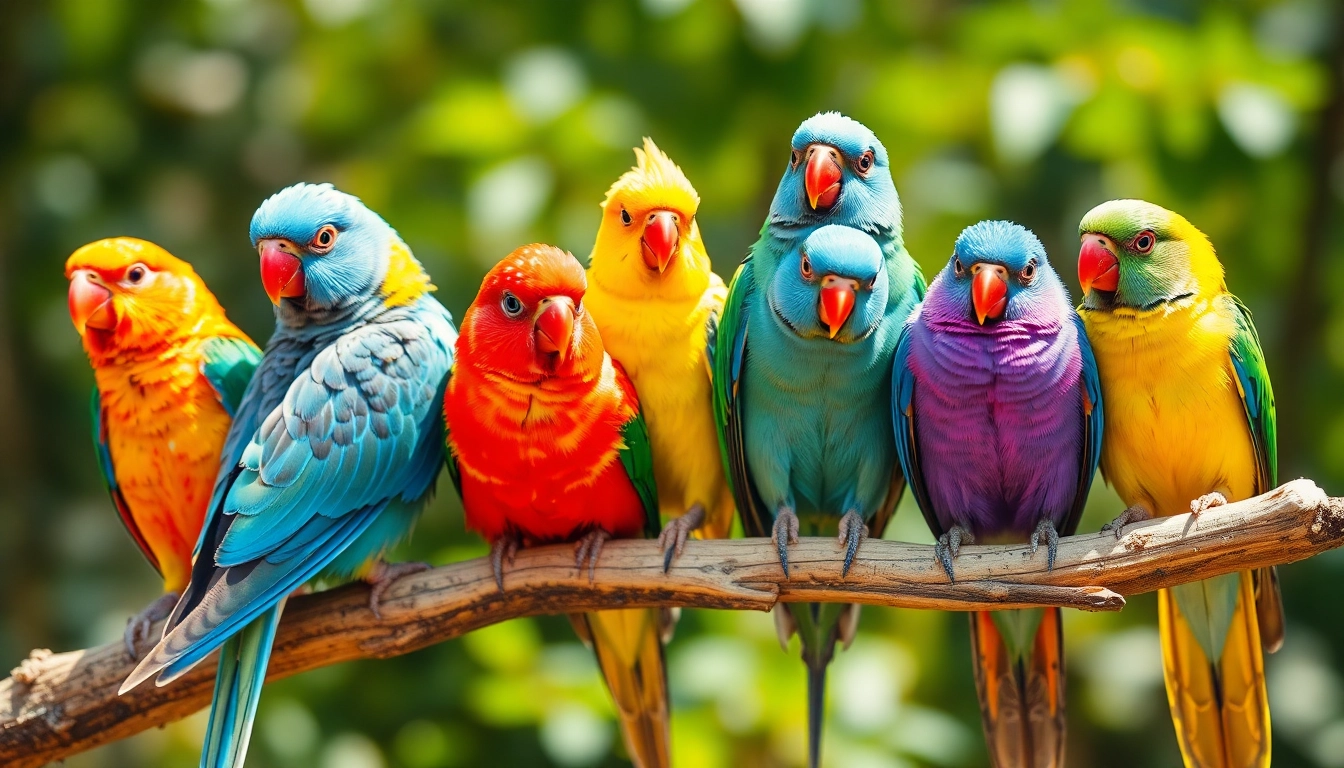Understanding Different Types of Pet Birds and Their Care Needs
Choosing the right pet bird involves understanding the diversity of bird species, their behavior, and specific care requirements. Pet birds are not only beautiful and engaging companions but also require a substantial commitment in terms of environment, nutrition, health care, and social interaction. Whether you are a beginner or an experienced bird owner, grasping the differences among popular bird species can significantly influence your success as a responsible pet owner.
For those considering welcoming a new feathered friend into their home, exploring the variety of pet birds available for sale or adoption, along with practical care tips, can make the process both enjoyable and manageable. From small, low-maintenance birds to intelligent parrots with complex social needs, the spectrum of pet birds offers something for every lifestyle and preference.
You can learn more about pet birds and their care, but this comprehensive guide will help you navigate the essential aspects of choosing, caring for, and enriching your bird’s life.
Popular pet bird species for beginners
For those new to avian companionship, selecting an easy-to-care-for and hardy species is paramount. The most popular pet birds for beginners include the budgerigar (commonly known as a parakeet), cockatiel, and zebra finch. These species are renowned for their friendly temperaments, manageable sizes, and relatively straightforward care needs.
Budgerigars (Budgies) are among the tiniest and most sociable parrots, making them ideal for first-time owners. They are relatively affordable, easy to train, and can live up to 15 years with proper care. Their cheerful chirping and playful nature make them delightful companions.
Cockatiels are slightly larger, known for their affectionate dispositions and expressive crests. They are intelligent and can learn to mimic sounds, which enhances their interactive appeal. Proper socialization from an early age ensures they develop trust and friendliness.
Zebra Finches are small, active, and hardy, requiring minimal interaction, which makes them suitable for busy households. Their vibrant markings and lively chirping add a cheerful ambiance to any room.
Other beginner-friendly species include Lovebirds and Parrotlets, which are small, vibrant, and tend to have manageable care routines. When selecting a starter bird, consider your available space, time commitment, and the bird’s lifespan — many of these species live between 6 and 18 years, offering long-term companionship.
Key differences between parrots, finches, and doves
Understanding the primary distinctions among these groups helps tailor your expectations and planning for their care:
- Parrots (e.g., Macaws, African Greys, Cockatoos): Known for their high intelligence, ability to mimic speech, and social needs. They often require mental stimulation and extended interaction. Parrots can live up to 80 years, making them a lifelong commitment.
- Finches (e.g., Zebra Finches, Society Finches): Small, active, and relatively low-maintenance. Finches are social birds that thrive in flocks and prefer spacious aviaries. They do not typically mimic sounds but are entertaining to watch with their dynamic behaviors.
- Doves (e.g., Ring-neck Doves): Gentle and calm, doves bring a peaceful presence. They are easy to care for and enjoy simple diets. Doves are often suitable for households seeking a serene pet bird experience.
Each group presents unique enrichment needs and social behaviors. Parrots demand complex environmental stimuli and social companionship, finches require space to fly and flock interaction, while doves benefit from a quiet environment and gentle handling.
Behavioral traits and personality profiles
Beyond species differences, individual birds possess distinct personality traits. Some are highly playful and curious, such as conures and lovebirds, while others are more reserved and independent, like certain finches or poicephalus parrots.
Understanding these traits helps in selecting a bird that fits your lifestyle. For example, an owner who enjoys interaction and active engagement may prefer a charismatic cockatoo or parrotlet, whereas someone seeking a low-key companion might opt for a solitary finch or dove.
Socialization also influences behavior: birds that are properly trained and accustomed to handling tend to be more trusting and people-oriented. Recognizing signs of behavioral issues, like biting or excessive screaming, enables owners to intervene early and promote a positive bond.
Essential Tips for Caring for Your Pet Birds
Proper cage setup and environment
The foundation of good bird care begins with creating an environment that mimics their natural habitat and meets their physical and psychological needs. An ideal cage should be spacious enough to allow free movement and flight for active species like finches and canaries. For larger parrots, a cage with sturdy construction and ample space is essential.
Position the cage in a well-lit, draft-free area that avoids direct sunlight and loud household noises. Natural light and a consistent day-night cycle support their circadian rhythms and overall health. Provide perches of varying diameters and textures to promote foot health and prevent foot deformities.
Incorporate stimulating elements such as toys, mirrors, and foraging items to encourage natural behaviors. Regular cleaning routines reduce the risk of bacterial or fungal infections. Use bird-safe cleaning agents and replace cage lining frequently.
Feeding and nutrition guidelines
Proper nutrition is critical for maintaining health, longevity, and vibrant plumage. A balanced diet varies among species but generally includes high-quality seeds, pellets, fresh fruits, vegetables, and occasional treats.
Some birds, like finches and canaries, thrive on seed-based diets supplemented with greens, while parrots often require more diverse, nutrient-dense pellets and fresh produce. Avoid feeding avian foods that are high in fat, salt, or toxins, and always wash fresh food thoroughly.
Vitamin supplements are rarely necessary if a complete diet is provided, but consult an avian veterinarian for tailored advice. Fresh water should be available at all times, changed daily to prevent bacterial growth.
Maintaining health and recognizing signs of illness
Regular health checks and early detection of illness are vital. Watch for changes in behavior, such as lethargy, decreased appetite, abnormal droppings, ruffled feathers, or respiratory distress. These signs warrant prompt veterinary evaluation.
Routine vaccinations and parasite prevention, along with a clean environment, support a healthy life. Establish a relationship with an avian veterinarian experienced in bird care for annual health assessments and emergency consultations.
Training, Socialization, and Enrichment for Pet Birds
Building trust and beginner training techniques
Training a pet bird fosters trust and enhances their quality of life. Start with gentle, consistent handling to build confidence. Use positive reinforcement—such as treats or praise—for desired behaviors like stepping onto your finger or singing.
Teaching basic commands like ‘step up’ and ‘step down’ lays the groundwork for more advanced training. Regular, short sessions prevent stress and promote learning. Be patient, as some species take longer to adapt and learn new skills.
Creating predictable routines and avoiding sudden movements help reduce fear and aggression. Engage your bird daily to reinforce the bond and provide mental stimulation.
Interactive toys and mental stimulation
Enrichment through toys and foraging activities prevents boredom, which can lead to destructive behaviors. Use a variety of toys, including puzzle feeders, bells, mirrors, and chewable toys suited to your bird’s size and preference.
Rotating toys weekly maintains novelty and engagement. Foraging toys simulate natural food-searching behaviors, keeping your bird active physically and mentally. Incorporate natural elements like branches or safe herbs for added enrichment.
Interactive playtime—such as training sessions, gentle flights within a safe environment, or music—further enhances their mental well-being and deepens your relationship.
Social needs and companionship considerations
Many bird species are social animals that require regular interaction. Examples include parrots and lovebirds, which thrive on companionship and can develop behavioral issues if neglected.
Providing a suitable mate or a consistent owner is essential for their psychological health. In cases where a solitary bird is preferred, select species like poicephalus parrots that are more self-sufficient.
Community bird groups or supervised socialization with other birds can be beneficial, but always ensure compatibility and monitor interactions to prevent conflicts.
Choosing the Perfect Pet Birds for Your Lifestyle and Budget
Low-maintenance pet bird options
If you have a busy schedule or limited experience, certain species require less daily attention and specialized care. Finches and doves are excellent choices due to their independence and minimal grooming needs. These birds typically settle into routine environments and require less social interaction than parrots.
Automated feeders, water dispensers, and suitable enclosures streamline maintenance tasks. Regular health checks still apply, but these species generally adapt well to routine households.
Budget-friendly species for first-time owners
Cost considerations extend beyond initial purchase; ongoing expenses include food, toys, cage maintenance, and veterinary care. Parakeets and finches are among the most affordable pet birds, with low purchase prices and inexpensive food options.
Buying from reputable breeders or adopting from rescue organizations can also reduce costs and promote ethical pet ownership. Remember, ensuring the bird’s health and happiness is worth the investment.
Long-term commitments and lifespan expectations
Birds are long-lived companions. Parrots, such as cockatoos and macaws, often live 50+ years, representing a lifelong commitment. Even smaller species like budgies and canaries typically live 10–15 years, requiring owners to plan for their care over decades.
Consider your future lifestyle changes, residence stability, and ability to provide continuous care before selecting a species. Proper research ensures an informed decision aligned with your capacity to nurture a long-term relationship.
Where to Buy and Adoption Resources for Pet Birds
Reputable breeders and pet stores
Purchasing from certified breeders or established pet stores guarantees healthy, ethically sourced birds. Reputable sources provide transparent lineage, health records, and advice on species-specific care.
Visit stores or breeders in person to observe the environment and ask about their breeding practices. Online directories regulated by avian organizations can help locate trusted providers. Always demand documentation of health and parental background.
Adoption and rescue organizations
Rescue groups and shelters are excellent avenues to find a pet bird in need of a caring home. Adopting prevents neglect and discourages irresponsible breeding. Many rescued birds come with behavioral histories, and staff can advise on matching them with suitable owners.
Rescue organizations often have specific protocols, including home inspections, health assessments, and counseling to prepare new owners for the responsibilities ahead.
Questions to ask before purchasing or adopting
Regardless of source, inquire about the bird’s health history, age, temperament, and socialization level. Questions such as “Has the bird been vaccinated or treated for parasites?” and “What is its daily routine?” are critical.
Understanding the bird’s history and needs helps ensure a good fit for your household and increases the likelihood of a successful, harmonious relationship.









